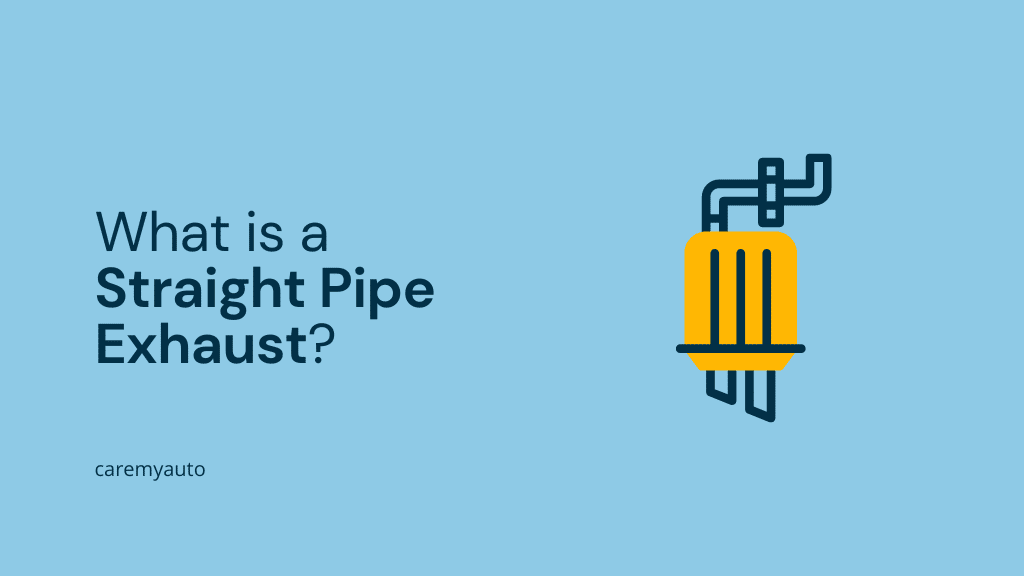Who doesn’t love loud cars? Well, being someone who’s into cars, I think we all can agree that we love cars that sound great. Be it the supercharger, turbo, or exhaust, cars that sound good never fail to turn our heads. Straight pipe exhaust is one of the many different exhausts that are available in the market. It is a popular choice for many car and truck enthusiasts because it is a simple and effective way to improve your vehicle’s performance.
You can know or not know how a car runs and still enjoy riding in a car.
– David Byrne
After reading this article, you’ll have a better understanding of what a straight pipe exhaust is and how it differs from the usual exhaust systems. Not only that but you’ll also get to know the pros and cons of owning such an exhaust system.
What Is a Straight Pipe Exhaust?
To straightaway answer your question, it is a type of exhaust system that does not include a muffler, catalytic converter, or resonator. Instead, it consists of a pipe that runs from the engine to the tailpipe, with no restriction on the flow of exhaust gases. This design allows for a more aggressive exhaust note and increased horsepower, but can also be louder and less compliant with emissions regulations. These components are included by car manufacturers to adhere to the various emission regulations set by the different countries and unions (e.g., European Union).
To summarize, the muffler, catalytic converter, and resonator work together to reduce the noise coming from the engine and exhaust system.
- The muffler reduces the noise by absorbing the sound waves and redirecting them.
- The catalytic converter helps to reduce the emissions from the engine by converting the pollutants into less harmful gases.
- The resonator helps to cancel out the low-frequency sounds coming from the engine.
Now you might have an idea of how a straight pipe exhaust differs from a normal exhaust, however, there are a few things you should know about straight pipe exhausts before you decide if they are right for you.
Things To Know Before Getting a Straight Pipe Exhaust
- Straight pipe exhausts are not legal in all states. If you live in a state that has emissions testing, you will not be able to pass with a straight pipe exhaust. In some states, you may be able to get a waiver for your straight pipe exhaust, but it is up to the individual state.
- These exhausts are loud. If you are looking for a quiet exhaust system, a straight pipe exhaust is not for you. These exhausts are designed to be loud and to improve the performance of your vehicle.
- They can be difficult to install. If you are not familiar with exhaust systems, it is best to have a professional install your straight pipe exhaust.
Benefits of a Straight Pipe Exhaust
A straight pipe exhaust is a type of car exhaust system that is commonly seen in high-performance vehicles. One of the main reasons why people would want this exhaust is because it offers its own set of benefits over a stock exhaust system.
- Increased horsepower: The lack of restriction on the flow of exhaust gases can result in an increase in horsepower and torque.
- Improved exhaust sound: A straight pipe exhaust produces a deep, aggressive exhaust note that is popular among car enthusiasts.
- Weight reduction: A straight pipe exhaust is typically lighter than a factory exhaust system, which can result in a slight reduction in vehicle weight and improved performance.
- Cost-effective: A straight pipe exhaust is a relatively inexpensive way to improve the performance of a vehicle.
- Easy to install: A straight pipe exhaust is a simple, bolt-on modification that can be installed by most car enthusiasts with basic mechanical skills.
How Do I Install a Straight Pipe Exhaust?
A straight pipe exhaust is one of the most popular and easiest ways to increase your vehicle’s performance. It is also one of the cheapest and most effective ways to give your car or truck a new look and sound. Depending on your make and model, a straight pipe exhaust can add up to 10 horsepower to your engine, and significantly improve your gas mileage.
Installing a straight pipe exhaust is a relatively easy project that can be completed in a few hours with basic hand tools. In most cases, you will only need a screwdriver, a wrench, and a socket set. Some vehicles may require additional tools, such as a drill, to remove old exhaust components.
Before you begin, it is important to consult your vehicle’s owner’s manual to ensure that you are not violating any warranty terms or voiding any insurance coverage. You should also check local noise ordinances to ensure that your new exhaust system will not be too loud.
The first step in installing a straight pipe exhaust is to remove the old exhaust system. This can be done by loosening the bolts that secure the exhaust pipes to the manifold and tailpipe. In some cases, you may need to drill out the rivets that hold the exhaust system in place. Once the old system is removed, you can install the new straight pipe.
To install the new pipe, simply connect the ends of the pipe to the exhaust manifold and tailpipe. In most cases, you will need to use a wrench to tighten the bolts or nuts that hold the pipe in place. Once the pipe is installed, you can start your vehicle and check for leaks.
If you hear any leaks, you can try tightening the bolts or nuts that hold the pipe in place. If the leaks persist, you may need to use a sealant or gasket to seal the joints between the pipe and the exhaust manifold or tailpipe. Once the leaks are fixed, you can enjoy the increased performance and improved gas mileage that a straight pipe exhaust provides.
Are There Any Drawbacks to a Straight Pipe Exhaust?
There are a few potential drawbacks to installing a straight pipe exhaust system on your vehicle.
- Increased noise: A straight pipe exhaust can be significantly louder than a factory exhaust system, which may not be legal in certain areas due to noise regulations.
- Increased emissions: A straight pipe exhaust can result in increased emissions, which may not be compliant with emissions regulations in certain areas.
- Reduced lifespan of catalytic converter: The lack of restriction on exhaust gases can cause the catalytic converter to overheat and fail prematurely, reducing the lifespan of the catalytic converter.
- Reduced engine lifespan: The straight pipe exhaust can cause excessive wear and tear on the engine and transmission, which can shorten the lifespan of the vehicle.
To Conclude
Overall, a straight pipe exhaust is a great way to improve your vehicle’s performance. If you’re looking for more power and better fuel efficiency, a straight pipe exhaust is a great option. Just be sure to check the laws in your state before you make the switch.
After going through this article, if you’re still thinking about upgrading to a straight pipe exhaust, then you should definitely do some research to find the right system for your car. There are a lot of different options out there, so you’ll want to make sure that you choose one that fits your car and your driving style. Once you’ve found the perfect exhaust, then you can enjoy the benefits of increased power and an amazing sound.
Do let us know if you have any questions regarding straight pipe exhausts in the comments and we’d be more than happy to answer them!



